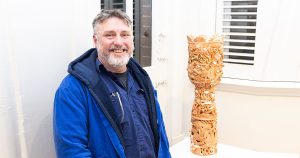
There are 2 types of Pittosporums growing in this area – Pittosporum revolutum and pittosporum undulatum. They are both natives. Pittosporum revolutum is a small shrub (mostly to 1.5m tall) that presents no problems. There are many in Carrs Bush (Fagan Park) and I like them, especially when the big yellow seeds open to show red flesh, advertising to all that “dinner is served”. Pittosporum undulatum is very different, growing to about 15m tall and wide, with lots of leaves causing dense shade underneath. This is the plant that many people don’t like.
Before Europeans arrived in Australia 250 years ago, Pittos (Pittosporum undulatums) grew naturally in rich soils between the coast and mountains from Southern Queensland to Victoria. Regular bushfires controlled their numbers. However, Europeans changed the soil conditions in much of this area by adding fertilizers and water to grow crops, exotic plants and keep extensive lawns green. Bushfires are now severely limited, especially in developed areas. Bare soil in gardens and on constructions sites resulted in soil erosion. The enriched soil washed into infertile sandstone gullies and also settled on areas that were already fertile.
Pittos responded eagerly to these changed conditions, spreading far beyond their original range. Botanists referred to them as “environmental weeds” and agreed to their selective removal in some places. It seems that over time, many people have forgotten these constraints and now regard them as simply “weeds” that should be removed everywhere they grow.
BUT LET’S STOP AND THINK FOR A WHILE:
• Pittos are local native plants that belong in the bush. Unless they are creating a major problem, leave them alone, learn to like them. If growing in suitable conditions they have green leaves all year, will survive droughts and flooding rains, have sweetsmelling cream-coloured flowers in Spring, orange berries in Summer and Autumn, provide habitat and food for birds and possums and shade to sit under on a hot day. Best of all, they need no maintenance.
• They can be used as a barrier to prevent weeds crossing into a weed free area. Very few weedy shrubs and groundcovers will grow in their dense shade.
• In remnant bushland in urban and peri-urban areas, they add native biodiversity.
That’s the good news. Could there be a downside?
Where soil is rich and water plentiful, Pittos might become “over-represented”, causing excess shade and loss of other valued native plants. If this is so, check if fertilizer or irrigation is being used anywhere uphill. Reducing this might solve the problem. If no other management issues are present, it might be OK to do what a low intensity bushfire would do – you could remove some Pittos to increase the light level in that area and leave more room for other natives. Do not remove them all. It would be responsible to leave the mature Pittos to ensure a continued seed supply. The bush will love you for caring.
Note: the views expressed in this article are mine and may not represent Landcare policy.
For more information, Contact Nick on 9653 2056, www.stillcreeklandcare.com.au email [email protected] or Facebook.











